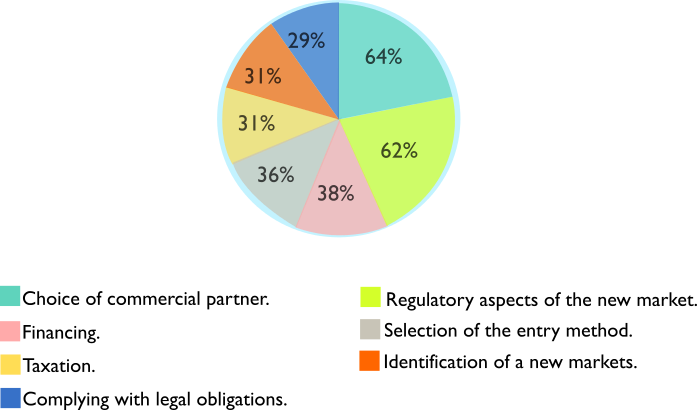The route to international success
[mtphr_grid span="6" start="true"]
Internationalisation is a structural process that has to involve the whole company to adapt the resources and processes to a new business scenario which not only is more complex and competitive but more profitable, sustainable and safe. The leap towards new markets would allow your company to keep growing while diversifying the risk of your investments. This requires detailed knowledge of both external reality and business practices in foreign countries and institutions. Success lies primarily in planning an appropriate international strategy, based on a rigorous analysis of the company, the potential markets and the existing opportunities, as well as in working together with the most professional collaborators and partners.
Main difficulties to internationalize
In an increasingly globalised context, internationalisation is a great opportunity to continue growing, work for prestigious and solvent entities, perform bigger projects and improve internally. 45% of the companies surveyed generate more than half of their annual turnover from their activities abroad. This percentage is expected to raise because 90% of the companies are planning to increase their international presence in the next two years.
Among the main obstacles companies normally face when expanding their businesses it is worth highlighting the selection of a commercial/industrial partner in foreign markets (62%) and, in a lower scale, access to financing (38%) and selection of the entry method (36%).
On the other hand, among the reasons to undertake an international expansion it is worth mentioning the increase in turnover (90%), the downturn in domestic demand (70%), the decision to diversify risks (43%) and the desire to boost competitiveness (30%).
[/mtphr_grid][mtphr_grid span="6" end="true"]
Reasons to internationalise
[mtphr_slide_graph title="Growth in turnover" title_width="300" percent="90" ]
[mtphr_slide_graph title="Compensate downturn in domestic demand" title_width="300" percent="70" ]
[mtphr_slide_graph title="Risk diversification" title_width="300" percent="65" ]
[mtphr_slide_graph title="Scale economies" title_width="300" percent="43" ]
[mtphr_slide_graph title="Increase competitiveness" title_width="300" percent="30" ]
[mtphr_slide_graph title="Lidle capacity" title_width="300" percent="15" ]
[mtphr_slide_graph title="Reputation" title_width="300" percent="8"]
Major success factors
[mtphr_slide_graph title="Competitive price" title_width="300" percent="62" ]
[mtphr_slide_graph title="Quality" title_width="300" percent="62" ]
[mtphr_slide_graph title="Brand" title_width="300" percent="38" ]
[mtphr_slide_graph title="Strategic partnerships" title_width="300" percent="33" ]
[mtphr_slide_graph title="Financing" title_width="300" percent="29" ]
[mtphr_slide_graph title="Logistics" title_width="300" percent="29" ]
[mtphr_slide_graph title="Human Resources" title_width="300" percent="24" ]
[mtphr_slide_graph title="R&D" title_width="300" percent="21"]
[mtphr_slide_graph title="Tax Planning" title_width="300" percent="14"]
[/mtphr_grid]


No comments.